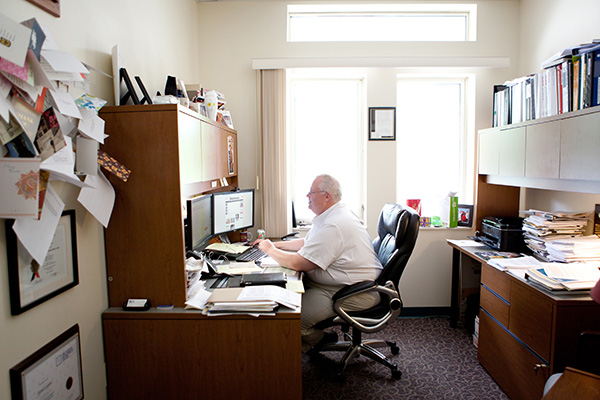Higher Tech
A couple blocks west of Main Street in Boonville, nine outdated buildings lie vacant on the former campus of Kemper Military School. When the City of Boonville decided to buy the facilities of the bankrupt academy at public auction in 2003, its intention was to use some of the 46 acres for a park and sell much of the rest.
Unused for a decade, the facility just might find new life within its original purpose, says Jim Gann, with the University of Missouri Small Business and Technology Development Center.

Gann is working with Boonville on a redevelopment project to bring back higher education to the city in the form of modeling the former military academy into an IT training center after the American Recovery and Reinvestment Act brought fiber to the area.
“Unemployment is higher west of Columbia, so we could train these folks [in Boonville] for Columbia jobs,” Gann says. IT is among Columbia’s most in-demand career opportunities.
According to the Bureau of Labor Statistics, occupations in network systems and data communications analysis are among the fastest-growing professions between 2008 and 2018, and Inc.com named software development one of the top five most difficult jobs to fill. In fact, it’s estimated that by 2018, there will be some 1.4 million tech-related job openings in the United States with less than 400,000 college graduates to fill them.
Room to hire
Columbia-based employers are already experiencing trouble on the IT front. Margrace Buckler, director of human resources with the City of Columbia, says she might receive between three and 10 applications for every IT position and spend four months seeking a suitable candidate, compared to the hundreds of applications she receives for each administrative position — which can be filled within a couple weeks.
Steve Powell, president of Delta Systems, a local Web application and software systems development company, says he’s still trying to fill positions that have been open since October 2012. Although the demand has remained level, “the number of players consuming that IT talent” has continued to increase, he adds.
“[The IBM workers] came from CarFax, MU and our insurance companies who now have to replace that talent,” Gann says. “At the same time, places like Veterans United are adding new jobs with these skills, so it’s created a huge vacuum of IT folks because our community couldn’t digest all of these additions at once.”

However, Gann says, there’s a lag between demand and supply of qualified workers when it comes to vocational and technical schools, which must demonstrate an existing need rather than look for future needs.
“For example, even though I’ll bet we’ll need plenty of 3-D printer operators a few years from now, it would be impossible to launch a course in it because the jobs don’t already exist,” he says.
He says the need for tech workers wasn’t quite so dire in the past, and he cites bulletin boards all over campus with fliers from computer scientists looking for work. When Datastorm, a Columbia-based startup that built the No. 1 modem software and eventually employed more than 500 people, was bought out by a Silicon Valley company, Gann says it “created a kind of cluster of skills that hung around here since then.”
Now, companies born in Columbia, such as Zapier — born from a collaboration among three former VU employees — that want to stay in Columbia cannot, according to Powell.
Addressing the shortage
Mike Brooks, president of Regional Economic Development Inc., which aims at attracting, creating and maintaining businesses in Columbia, seconds the shortage of IT workers and says the added pressure on an already tight labor market has left Columbia playing catch-up to find qualified computer gurus.
“And IT workers are needed everywhere, so [these companies] aren’t just competing in the IT arena, but [they’re] also competing with everyone else for that talent,” Brooks says. In fact, the difficulty of finding qualified workers has pushed some Columbia-based employers to open offices elsewhere.
“Veterans United is the perfect example; they’re looking to open an office in another city because they can’t find the skills here,” Brooks says.
Powell, who lost 40 percent of his Columbia staff to Veterans United when they opened in the early 2000s, is also looking elsewhere.
“We’re working to open an office in Boise, Idaho, after one of our employees relocated there,” he says.
According to a recent study done by Economic Modeling Specialists Inc., a subsidiary of CareerBuilder.com, the state of Missouri has the eighth-largest surplus of workers trained in IT, with more than 3,400 graduates from IT-related programs and less than 2,500 IT job openings in 2012. Idaho, on the other hand, has a minor shortage of IT workers. However, Powell estimates that Missouri’s metro areas of Kansas City and St. Louis throw off the state’s numbers. “I don’t think Columbia has an abundance of extra IT people sitting around,” he says.
“[Boise’s] a bigger town…the fact that [Columbia’s] a small town is limiting,” he says. “We don’t have that ‘churn.’”
“I mean, look at the insurance industry,” Powell says. “People come to Columbia just to work in that industry and move around within it. We don’t really have that in IT, like Austin, Texas, does, where there are 100,000 people like me…but I think we’re getting there.”
He says one key element to create the level of churn to make Columbia a destination for IT workers is keeping our computer science graduates around after they get their diplomas. Brooks agrees.
“The more we can do to connect our IT students to the community, the better off we are to keep them from taking those skills home,” Brooks says. “The question is how can we make sure to keep them here.”
Theorists vs. technicians
Successful Start-Up Weekends and interest groups such as Dev Como, a monthly user group focused on development and design, are two attraction methods Powell is familiar with, and Brooks tacks on more involvement between local employers and organizations of higher education in the form of guest speakerships, field trips and internships. But it isn’t simply an issue of quantity; the issue of quality must also be addressed.
Both cite that greater collaboration between industry and education are immensely helpful, and Powell sits on MU’s computer science advisory board.
“I sent an open letter to them saying if I got one more resume where the best thing on there is that they worked at Pizza Hut, I’d die,” he says half jokingly, adding a second annoyance: relevant coursework.
“Did you know you could graduate with a computer science degree and only take one course in databases, and even then you only covered the theory behind them?” he asks. For Powell, real-world experience is a must, whether that’s an internship or “building a website for your mom.” He says plenty of coursework students go through is unnecessary to work for Delta Systems and cites a high-level encryption course every computer science student at MU is required to take.
“Ninety percent of the time, [my company] is just going to use an encryption method someone else built, so why do 100 percent of students need to learn it?” he says.
What is certain is that the need among employers is across the board. Gary Lee, chief technology officer with Veterans United, says for a field that is “all about invention and innovation,” the most important skill is the ability to learn and adapt.
“A great computer science curriculum is about teaching problem solving and the application of scientific principles rather than any particular skills or technology,” he says.
Even still, Buckler with the City of Columbia has a different set of needs — simply people who can help when something goes wrong.
“It used to be that [the IT people] do it all and hand it back to the user,” he says. “Now the users need to know the system, and the IT people really need to know how to solve [the users’] problems.”
So really, what they all need is problem solving. But for companies that have such different problems, what education plan could both broadly applicable and specific to companies’ problems? For Buckler, the city has decided to train some of its own current workers in more highly skilled positions. For Lee, a main strategy is VU’s strong internship program.
Gann believes the answer might also be in the diversification of education.
“In my opinion, MU is a research institute, so their educational mission is different from other schools,” he says. “Technology is the application of science. MU doesn’t create technicians; it creates theorists.” He likens it to the market for registered nurses compared to doctors. “For technicians, we should be looking to other options and other schools.”
This is something Brooks has also noticed.
“The grads that come out of MU have one set of skills, and those that come out of [Moberly Area Community College] have a different set, and each school is developing coursework based on what they see as a need,” he says.
According to think tank The Economic Policy Institute, half of computer and information science graduates in the United States are unable to find jobs within their fields. And though tech companies taut an unemployment rate of 3.5 percent — less than half the national rate — that percentage is perfectly in line with other professional occupation rates. Meanwhile, wages in the tech industry are increasing more slowly than those of the economy as a whole, flat lining near their late 1990s level.
One scenario that could make sense of both an increased demand and comparatively lower salaries is a decreasing barrier to entry into the field, with more opportunities for self-taught, super specific or less skilled workers.
“To some extent, [IT becoming more of a skilled trade rather than a profession] has already happened,” says Brooks, who taught himself the programming language dBase and later wrote software for the Bloomington Chamber of Commerce. “That just shows you the level of skill that must be learned to be useful.”
Powell says getting specific to a company’s needs might also work, citing the partnership between OnShore Outsourcing, an IT services company, and Macon Area Community College, where graduates would be a .NET Microsoft-certified professional.
“Those graduates are in demand right out of school,” Powell says. “[OnShore] said that if Macon made this course, they would hire the graduates and pay about $40,000 as a starting salary.”
Brooks and REDI attempted to close the gap in Columbia with a training program this summer, funded with assistance from the federal office of Housing and Urban Development, but the sequester has kept the funding unavailable until fall, when Brooks says it becomes much more difficult to find faculty to teach the course, along with a place to host it.
With its proposal still under discussion, an IT training facility in Boonville may be another option. Another option may be in the design of existing programs. For example, Moberly Area Community College currently has a program in mechatronics that is designed so students obtain useful certificates as they go, so the training is valuable with or without an eventual degree.
“It used to be that vocational school was somewhere you’d go to learn to weld and stuff, but programming is becoming more of a vocation,” Powell says. “Ultimately, I think [the answer] will be a blend of what the university does from an academia standpoint to what can be done on the vocational end.”
“It seems these days everyone’s expected to go to college,” Buckler says. “But not everyone needs to go to college. There are plenty of people that we need to hold it all together.”


